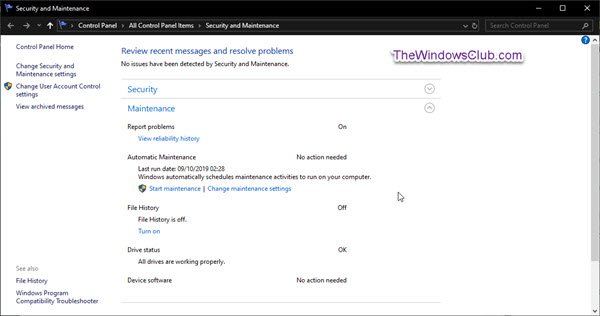By default, Windows automatically searches for issues related to Windows Update, network firewall, Windows troubleshooting, and other items, and sends you a message if problems are detected. In this article, we will show you how to enable or disable specific security and maintenance messages for your account in Windows 10.
What are the Windows 10 security and maintenance messages
Windows 10 uses the Security and maintenance applet to keep you informed about issues related to the health of your computer. The screen divides the issues into sections Safety and Maintenance.
To open the Security and Maintenance applet, type Security and maintenance in the search box of the Windows taskbar and select it in the result.
Write down all messages displayed under Examine recent messages and solve problems.
Normally, you see No problem was detected by Security and Maintenance.. So, if you see a message regarding a specific problem, select it for more information.
The Reliability Monitor can help you identify hardware and software issues.
Then select the security heading in the Security and Maintenance window.
This section expands to detail the security features. Each option should display On or OK.
Brief description of each element under security
- Network firewall: The firewall analyzes Internet traffic and blocks the activity of programs that do not have explicit permission to use Internet access. When you install a program using the Internet, you may be asked to approve the connection for the first time. The safest practice is to reject online connections that you have not initiated or recognized.
- Antivirus protectionIt is essential that your computer is protected against viruses. Windows Defender provides virus protection, although you can install another antivirus program.
- Internet security settingsThese settings affect your browser. The default settings may be adequate.
- User Account Control (UAC): This function notifies you of programs attempting to make changes to your system and asks you to confirm these changes. In particular, the user account control lets you know when a program is trying to run or install a potentially malicious software. If in doubt, say No or Cancel UAC messages.
Then select the Interview heading to see what this section includes (see screen capture below).
Brief description of each item under Maintenance
- Report problems: This setting is enabled, allowing Windows 10 to periodically search for solutions to problems it discovers.
- Automatic maintenance: Your computer automatically performs critical updates, security scans, and diagnostics daily.
- File History: The file history is disabled by default.
- State of driving: Drives are hard disks built into or connected to your computer. Your documents, photos, and Windows 10 itself are stored on one or more drives. Ideally, the state of the drive is All drives work properly.
- Device softwareIf a device on your computer requires a driver or other type of software to work properly, you are notified here. Select Install Device Software to install the software.
Disable security and maintenance notifications
You can enable or disable security and maintenance notifications in Windows 10 with the help of:
- Applet Security and Maintenance Control Panel
- Group Policy Editor
- Registry Editor.
Let's see how to do that.
1) Using the Security and Maintenance Control Panel Applet
To open the Security and Maintenance window, type Security and maintenance in the search box of the Windows taskbar and select it in the result.
Click on Change security and maintenance settings link on the left side.
Enable or disable the desired security and maintenance messages, and then click OK.
You can now exit the Security and Maintenance window.
2) Disable Security and Maintenance Notifications Using a Group Policy Object
Run gpedit.msc to open the Group Policy Editor and access the following settings:
User Configuration> Administrative Templates> Start Menu and Taskbar
Double click Delete notifications and action center and put it to enabled.
This policy setting removes notifications and the action center from the notification area of the taskbar. The notification area is located at the far right of the taskbar and includes icons for current notifications and the system clock. If this setting is enabled, Notifications and Action Center are not displayed in the notification area. The user will be able to read the notifications when he appears, but he will not be able to view the missing notifications. If you disable or do not configure this policy setting, Notification, Security and Maintenance will be displayed in the taskbar. A reboot is required for this policy setting to take effect.
3) Disable security and maintenance notifications with the help of Registry Editor
Run regedit to open the registry editor and access the following key:
HKEY_CURRENT_USER SOFTWARE Policies Microsoft Windows Explorer
Right-click on Windows> select New> Key. Name it as an explorer.
Now, right-click Explorer> select New> DWORD Value (32-bit).
Name it DisableNotificationCenter. Then double-click it and set its value to 1.
If Explorer does not exist, you must create it.
I hope this helps you!







